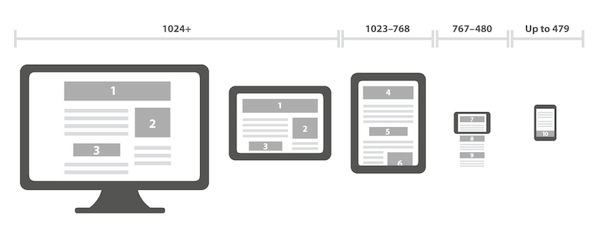Google has raised its demand for a quality user experience, so it’s no wonder responsive design is back on everyone’s mind.
Google’s announcement that responsive web design is its preferred method for mobile delivery, coupled with its recent announcement of an algorithm change favoring best-in-class mobile infrastructure, makes it clear that responsive design should be a technique webmasters are putting to use.
Richard Kirk’s article, “Google Makes Non-Desktop SEO an Absolute Necessity“, digs deeper the infrastructure piece, while this article focuses primarily on the framework and rapid deployment of responsive design.
What is Responsive Design?
In short, responsive web design is the integrated use of CSS, scripts, and HTML that allows a website to adapt to various device resolutions. User experience and design enthusiasts hail that it provides ideal experiences across a variety of screen sizes.

The Rise of Front-End Frameworks!
To aid the world in rapid deployment of responsive design, front-end frameworks like Bootstrap, Foundation 3, YAML 4, and Helium were created. The idea is to provide a framework that allows quick development of front-end design without having to hire 9 million (exaggeration) creative, web, and dev specialists. These systems are jam-packed with all sorts of fonts, CSS grids, widgets, and transitions baked in.
So you can understand why the adoption rate and use of front-end frameworks is so high.
Pitfalls to Consider Before Pushing the Framework Approach
- Security & Support: The majority of complete front-end frameworks are open source. Meaning extensions, plug-ins, modules, and code changes are supplied by and supported by a community of developers worldwide. The integrity of the code shared may not always be secure for your infrastructure. Your site may be exposed to front-end code injection. Opt for a commercial license if available and ensure you’ll get support for the core team.
- Increased Load Times: Your website can suffer from code bloat, from unused code snippets that are left over. Remember, these are buckets of pre-compiled code to help make code compilation faster. So whatever you don’t use, if you don’t want to spend tons of time removing, it just sits there.
- Installation: Not all frameworks are created alike. Some are complicated to install or require configuration, reducing time to market.
- Learning Curve: Understanding how to use the framework to construct pages can range from easy to difficult. The longer it takes to learn the framework you decide to use, the longer it takes to deploy your responsive design.
- Design Limitations: Many frameworks have layouts already integrated, so the limitation comes in that the end results tend to be very similar. As the adoption rate increases, the amount of diversity around the design aspect can dwindle. Web designer Joshua Gross wrote about this very subject here.
Summary
A framework is a great approach to rapidly deploying a responsive design website; however there can be potential pitfalls. If you decide to use a framework ensure you have a plan in place.
For example, take security precautions so you don’t open your website to vulnerabilities. If you want to provide a quality user experience, be prepared to remove code or select a simple grid system framework that removes all the bells and whistles, and just gives you the layout aspect.
But, most of all, remember, consult your developer and/or development team before assuming a framework can work for you or your business.
